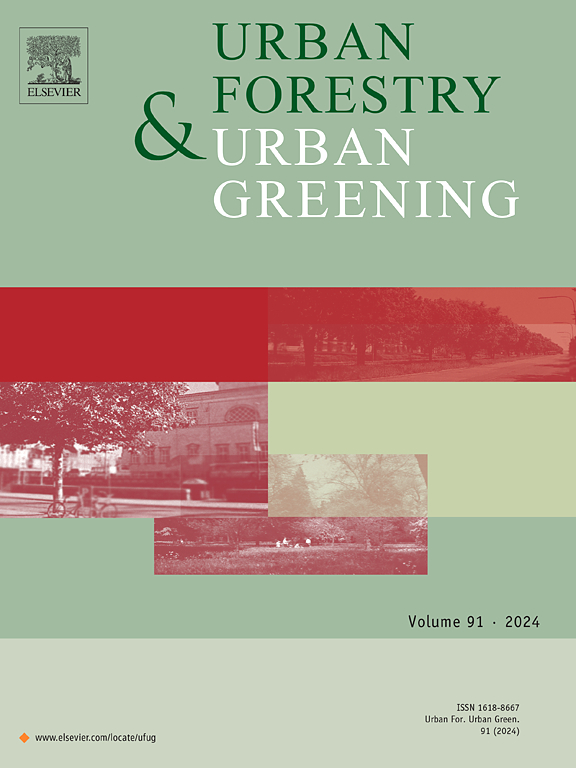Social licence to eradicate invasive pests of trees in urban landscapes: A review to prepare for the next incursion
IF 6
2区 环境科学与生态学
Q1 ENVIRONMENTAL STUDIES
引用次数: 0
Abstract
Invasive exotic pests and pathogens (hereafter “pests”) of trees are moving and establishing across the globe at unprecedented rates causing enormous economic, environmental, cultural and social harm. Commensurately, eradication attempts of newly detected exotic pests are burgeoning, with many occurring in urban landscapes where pests are often first detected. While early detection of invading pests is critical to the success of an eradication program, there is a growing need to obtain social licence to operate during a biosecurity response, especially in urban landscapes where multiple stakeholders can hold divergent values on urban trees. Biosecurity measures to eradicate an exotic pest (e.g., tree removal or pesticide/biopesticide application) are often contentious in urban areas and have been identified as a limiting factor in eradication success. Gauging and gaining social licence for control measures in a biosecurity response is needed in advance of the next pest arrival. This review identifies key elements for attaining social acceptability of biosecurity measures before and during a biosecurity response in urban landscapes to assist community and biosecurity agencies prepare for the next exotic pest incursion. Several actions can be taken. Relevant stakeholders can be identified now, their expectations and knowledge base understood, and relationships formed to gain trust and participation in future responses. Understanding public acceptance of biosecurity measures will help gain and maintain social licence in different contexts and develop appropriate communication and engagement approaches. Raising stakeholders’ awareness of the risks and costs of biosecurity incursions and the value of eradication measures can be enhanced when using participatory or co-design approaches and subsequently increase social acceptability of response operations. Reviewing social alongside technical aspects of eradication programs can shed light on ways to improve future programs as well as programs in-progress to support operational success.
消除城市景观中树木入侵害虫的社会许可:为下一次入侵做准备的综述
外来入侵的树木害虫和病原体(以下简称“害虫”)正以前所未有的速度在全球范围内移动和建立,造成巨大的经济、环境、文化和社会危害。相应地,根除新发现的外来有害生物的尝试正在迅速发展,其中许多发生在经常首次发现有害生物的城市景观中。虽然早期发现入侵害虫对根除计划的成功至关重要,但在生物安全应对过程中,越来越需要获得社会许可,特别是在城市景观中,多个利益相关者可能对城市树木持有不同的价值观。根除外来有害生物的生物安全措施(例如,砍伐树木或施用农药/生物农药)在城市地区经常引起争议,并已被确定为根除成功的限制因素。在下一次虫害到来之前,需要对生物安全应对中的控制措施进行评估并获得社会许可。本综述确定了在城市景观生物安全响应之前和期间实现社会可接受的生物安全措施的关键要素,以帮助社区和生物安全机构为下一次外来有害生物入侵做好准备。可以采取一些措施。现在就可以确定相关利益相关者,了解他们的期望和知识基础,并建立关系,以获得信任和参与未来的响应。了解公众对生物安全措施的接受程度将有助于在不同情况下获得和维持社会许可,并制定适当的沟通和参与方法。通过采用参与性或共同设计方法,可以提高利益攸关方对生物安全入侵的风险和成本以及根除措施的价值的认识,并随后提高社会对应对行动的接受程度。对根除计划的社会和技术方面进行审查,可以阐明如何改进未来的计划以及正在进行的计划,以支持业务成功。
本文章由计算机程序翻译,如有差异,请以英文原文为准。
求助全文
约1分钟内获得全文
求助全文
来源期刊

Urban Forestry & Urban Greening
FORESTRY-
CiteScore
11.70
自引率
12.50%
发文量
289
审稿时长
70 days
期刊介绍:
Urban Forestry and Urban Greening is a refereed, international journal aimed at presenting high-quality research with urban and peri-urban woody and non-woody vegetation and its use, planning, design, establishment and management as its main topics. Urban Forestry and Urban Greening concentrates on all tree-dominated (as joint together in the urban forest) as well as other green resources in and around urban areas, such as woodlands, public and private urban parks and gardens, urban nature areas, street tree and square plantations, botanical gardens and cemeteries.
The journal welcomes basic and applied research papers, as well as review papers and short communications. Contributions should focus on one or more of the following aspects:
-Form and functions of urban forests and other vegetation, including aspects of urban ecology.
-Policy-making, planning and design related to urban forests and other vegetation.
-Selection and establishment of tree resources and other vegetation for urban environments.
-Management of urban forests and other vegetation.
Original contributions of a high academic standard are invited from a wide range of disciplines and fields, including forestry, biology, horticulture, arboriculture, landscape ecology, pathology, soil science, hydrology, landscape architecture, landscape planning, urban planning and design, economics, sociology, environmental psychology, public health, and education.
 求助内容:
求助内容: 应助结果提醒方式:
应助结果提醒方式:


